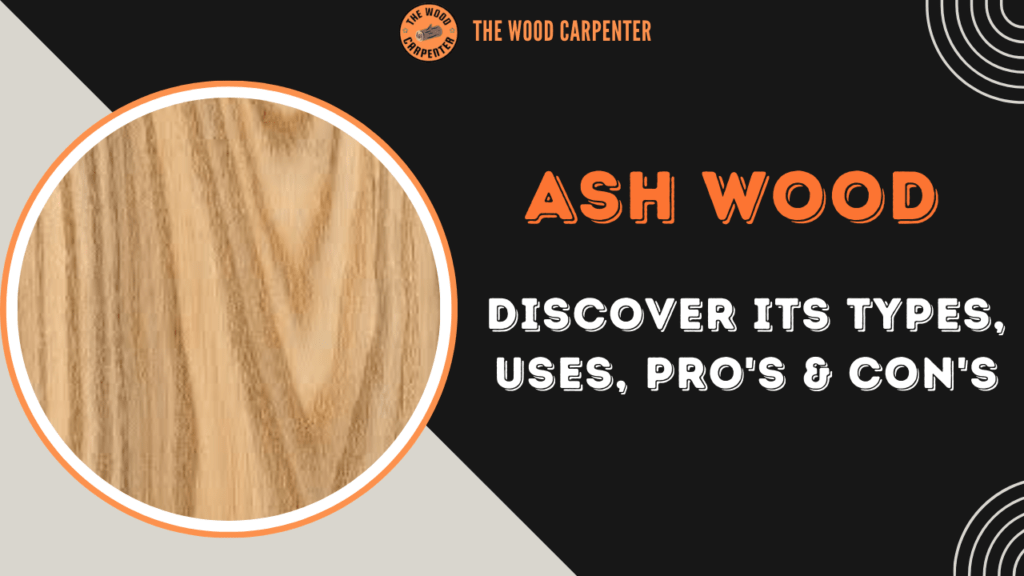
Ash wood is one of the most popular hardwoods around and a great choice for any woodworking project. No matter if you’re building furniture, flooring or even outdoor structures, there are plenty of reasons to consider an ash wood for both old and new woodworking projects.
We’re going to dig into all the facts about ash wood, from what it is and what it’s best used for, to why this is still a favorite among carpenters and designers.
What Is Ash Wood?
Ash timber comes from trees of the Fraxinus genus, which there are many; White ash (Fraxinus Americana) and European Ash (Fraxinus excelsior) being the most common. The trees, which grow in different parts of North America, Europe and Asia, are valued for their straight trunks and hard, heavy wood. The ash tree grows to a height of 40 m (131 feet). Ash trees normally grow in a temperate climate.
The wood is noted for its light color which varies from light brown to very pale and a rich, natural grain, so it’s great for an assortment of uses.
Properties of Ash Wood
Appearance
Ash wood is characterized by its pale, yellowish-brown heartwood and lighter sapwood. The grain is typically straight, though some boards may exhibit a slightly wavy or curly pattern, especially in varieties like Olive Ash. The wood’s texture is medium to coarse, with large pores that are visible under magnification, making it easy to identify.
Durability
Ash is a hard wood but it’s not as durable to outdoor elements like some other hard woods such as Oak. It is reasonably resistant to pests and deterioration though it will decompose when in direct contact with water for extended periods. For this reason, it’s best indoors unless you have it treated for use outdoors.
Workability
One of the reasons woodturners like ash is because of its ease of workability. Ash wood is also reasonably easy to saw, cut-plane and sand-machine or hand tool can be used. It is a very porous which means it will accept a stain when applied to it. And when you work with it in a perfectly finished and handled surface, the final product looks great.
Strength and Flexibility
Ash is an extremely dense and strong wood with good shock resistance, and ideal for tool handles, sports equipment, and furniture. It is one-fifth as strong and half the weight of oak, yet it won’t split under pressure. As such, it is perfect for items that will be used repeatedly and subjected to rough handling.
Moisture Movement
Ash has a high moisture content, and can expand and contract with humidity. This is especially important for woodwork projects, such as wooden floors or furniture which may expand and contract with fluctuations in temperature and humidity.
Types of Ash Wood
There are other varieties of ash, all having their own particular characteristics. The most commonly used types of ash are:
White Ash (Fraxinus americana)
White Ash is one of the most widely known and used species, primarily found in North America. It has a pale color with a slightly darker heartwood and is known for its strong and resilient properties. White Ash is used extensively in furniture making, flooring, tool handles, and sports equipment such as baseball bats.
Black Ash (Fraxinus nigra)
Black Ash is native to North America and tends to have a darker heartwood than White Ash. It is often used in the process of basket weaving because it is flexible and soft. Black Ash is rarely used as a structural timber but has many other popular uses.
European Ash (Fraxinus excelsior)
European Ash is comparable to White Ash, but the grain is typically finer, and often more uniform in color. It is a common wood in furniture, millwork and paneling but it’s not as popular for making relatively low-cost goods such as wooden boxes or particle board.
Oregon Ash (Fraxinus latifolia)
Oregon Ash -Native to the Pacific Northwest, Oregon Ash holds a straight grain and fine texture. It’s commonly employed for many purposes, including furniture, flooring and cabinets; however, it’s not commonly used as readily at White Ash or European Ash.
Green Ash (Fraxinus pennsylvanica)
Green Ash is a fast grower and offers good resistance to shock. Its principal use is for furniture, cabinetry and tool handles plus being a source of firewood wherein it burns for extended periods giving a high heat output.
Common Uses of Ash Wood
Furniture Making
Ash is a solid wood that comes with a range of grain patterns and qualities. It is primarily used in furniture creation, cabinetry.
Flooring
What makes ash one of the best hardwoods for flooring is that it tough and not prone to damage. It will look great and stand up to wear for 20 or more years, even in a full household. The wood’s beautiful grain adds warmth and richness to any room.
Tool Handles and Sports Equipment
Ash is also used in making drum shells and guitar bodies (known as swamp ash) and veneers. It is also widely preferred due to its cost-effective structure, beautiful surface quality, tough nature and strong hardwood abilities to resists shock; such as handles on tools like hammers, axes and spades.
Ash is also used to make baseball bats and it has the perfect strength requirements for hard hitting sporting equipment.
Veneering
High-quality construction uses wood veneer to cover solid wood such as ash. Its very appealing grain pattern makes it ideal for use as a veneer, where appearance is important such as cabinetry, paneling and decorative accents.
Firewood
Woodash ash Burns well and is in high repute as firewood. Its calorific value is close to oak and beech, giving a regular flame with minimal sparkling. They are no great trouble to split, and they season so quickly that they make the perfect fuel for a home.
Maintenance and Care for Ash Wood
Ash wood is a strong and long-lasting wood but it too will need some maintenance if you want to keep it in top condition – even more so if you´re using ash wood for furniture or flooring.
Cleaning: Always use a lint free cloth or micro-fiber cloth when cleaning ash wood surfaces. Don’t put the water directly on the wood or else you’ll end up with swollen, damaged wood from too much moisture.
Oiling and Polishing: Oiling or polishing ash wood furniture will give it a fresh new look and it also makes it to protect from the surface scratches. For bringing out the grain of the wood, nothing beats an oil-based finish. It’s natural oil penetrates into the wood in a very natural way.
Protection from Moisture: Ash wood products need to be kept away from the water because if it is over-exposed to the moisture or water, it will cause the ash to swell and warp. It’s even more important when you’re talking of ash in an open space because the raw wood is susceptible to rotting.
Ash Wood Disadvantages
Disadvantages of Ash Wood
Prone to Insect Infestation: It’s also susceptible to bugs including the emerald ash borer, which has caused the death of millions of ash trees in the U.S. and Canada.
Cost: It’s an expensive form of wood (compared to other wood like oak) and can sometimes make some projects, especially larger ones, a little costly for some.
Limited Availability: Ash lumber is limited in supply in some areas due to the infestation of ash trees and a decline in ash tree populations, making it costly for people that want ash wood.
Color Variations: Although there are many people appreciate the natural beauty of ash wood, many feel that it is very pale and does not suit all the design preferences – especially for people who like the dark shades of woods.
Ash Wood Color
Ash has a wide range of color variation, depending on the species and the age of the tree. Ash wood is generally light in color, often with a light, brownish-gray heartwood. The sapwood, which can be white, is generally lighter in color.
The grain of the wood is generally straight, however olive ash, a type of ash known as Olive Ash, can have a much more wavy, marbled look that adds to the woods appeal and charm.
Ash wood comes in colors that are adaptable for a number of different design styles — from traditional to modern. It can be stained or finished if you want a darker or more consistent look.
The lighter natural color of ash wood can help introduce lightness to interiors, while the grain patterns in the wood add a sense of texture and interest to furniture or decorative pieces.
Ash Wood Price
The price of ash wood can vary depending on factors such as location, grade, and whether the wood is treated. Generally, ash is considered a mid-to-high-range priced hardwood due to its durability, strength, and aesthetic value.
White Ash: Generally, the white ash costs more than the other woods, it ranges from around $4 to $8 per board foot for select-grade boards.
Black Ash and European Ash: It is slightly budget-friendlier, and these varieties average from $3–$6 per board foot.
Heat-Treated Ash: Heat-treated ash is more durable and can be 50% more expensive than the untreated wood (used for outdoor projects as well).
Factors Influencing Price:
Availability: Due to emerald ash borer, ash wood is becoming less available in some areas, and the price is rising accordingly.
Treatment: Treated outdoor-ready or heat-treated wood is more expensive than untreated ash wood.
Grade: A higher quality ash such as clear or straight-grain boards generally cost more than lower grade and smaller boards.
Ash Wood vs Other Woods Comparison Table
| Property/Feature | Ash Wood | Oak Wood | Maple Wood | Walnut Wood | Teak Wood |
| Scientific Name | Fraxinus | Quercus | Acer | Juglans regia | Tectona grandis |
| Color | Pale brown to light beige, with visible grain patterns | Light to medium brown, with visible rays in quartersawn | Pale cream to light brown | Rich dark brown to purplish-black | Golden to medium brown with dark streaks |
| Grain Pattern | Straight grain, sometimes wavy or curly | Straight grain, often with prominent rays | Straight grain, fine texture | Straight grain with occasional burl patterns | Straight, fine grain with interlocking pattern |
| Density | Medium (710 kg/m³) | Medium to heavy (750-800 kg/m³) | Medium to heavy (705-750 kg/m³) | Heavy (640-800 kg/m³) | Heavy (650-750 kg/m³) |
| Durability | Moderate, not recommended for outdoor use without treatment | Very durable, suitable for outdoor use | Moderate, better for indoor applications | Very durable, resistant to wear | Extremely durable, highly resistant to water and pests |
| Workability | Easy to work with, responds well to sanding and finishing | Easy to work with, can be difficult to stain | Easy to work with, but difficult to stain evenly | Hard to work with, but takes stain well | Easy to work with, but difficult to finish to a high gloss |
| Strength | Strong, good shock resistance | Very strong and tough, high resistance to wear | Strong but less resilient than ash and oak | Strong and stable, but not as shock-resistant | Very strong, resists wear and tear well |
| Flexibility | Highly flexible, good for bending applications | Less flexible than ash, rigid | Less flexible, brittle compared to ash | Moderate flexibility, good for detailed work | Very flexible, ideal for outdoor and boat use |
| Common Uses | Furniture, flooring, tool handles, sports equipment | Furniture, flooring, cabinetry, barrels | Furniture, cabinetry, butcher blocks, flooring | High-end furniture, cabinetry, veneers, gunstocks | Outdoor furniture, decking, boat building, flooring |
| Price | Mid to high-range | Mid-range to high depending on grade | Mid-range | High-range | High-range, premium wood |
| Moisture Resistance | Moderate; needs protection for outdoor use | Very high, great for outdoor furniture | Low; best for indoor use | High; used in both indoor and outdoor applications | Excellent, highly resistant to moisture and decay |
| Sustainability | Currently at risk due to pests like emerald ash borer | Readily available and widely sustainable | Generally sustainable, though harvesting can be intense | Moderate, mainly sourced from slow-growing trees | Sustainable when harvested responsibly, but slow-growing |
| Environmental Impact | Vulnerable to pests, which may limit future supply | Sustainable when harvested responsibly | Often harvested from forests, can be environmentally taxing | More environmentally taxing due to slower growth | High environmental impact due to slow growth rate |
| Care & Maintenance | Needs regular cleaning and protection from moisture | Easy to maintain, often requires only occasional oiling | Requires care to avoid scratches, low resistance to moisture | Needs minimal care but high maintenance for luxury finishes | Requires periodic oiling, resistant to moisture but can become weathered |
| Cost per Board Foot | $4 – $8 | $5 – $10 | $4 – $7 | $12 – $20 | $10 – $15 |
Ash Wood FAQ
1. What is Ash wood used for?
Ash wood can be used for furniture, tool handles, baseball bats, and firewood.
2. Is Ash wood durable?
Ash wood is indeed very hard and also tough, therefore it must be excellent for use as furniture, sports equipment, etc.
3. Can Ash wood be used outdoors?
It is also not ideal for outdoor applications unless it’s treated because it can be ruined by fungus and bugs like termites when exposed to water.
4. How do you care for Ash wood furniture?
Ash wood furniture should be cleaned with a lint-free cloth and maintained by periodically oiling or polishing the surface. It should be kept away from excessive moisture to prevent swelling or warping.
5. Why is Ash wood expensive?
Ash is a bit more pricey compared to other types of wood because it is strong, has beautiful grain. It’s also scarce because of pests like the emerald ash borer, driving up prices further.
6. What is the color of Ash wood?
Ash wood is typically light in color, ranging from pale beige to light brown. The heartwood may be darker in some cases, and varieties like Olive Ash exhibit a marbled, darker grain pattern.
7. Is Ash wood easy to work with?
Yes, ash wood is easy to work with. It can be easily sawed, sanded, and stained, thus making it popular among the woodworkers.
8. How does Ash wood compare to Oak wood?
Ash wood is similar to oak in terms of strength and durability but is lighter in color and tends to be more flexible, making it ideal for applications like baseball bats and tool handles.

